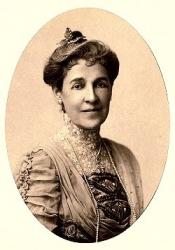- |
User Links
Florence Earle Coates

www.hymntime.com/tch
| Short Name: | Florence Earle Coates |
| Full Name: | Coates, Florence Earle, 1850-1927 |
| Birth Year: | 1850 |
| Death Year: | 1927 |
Florence Van Leer Earle Nicholson Coates (July 1, 1850 – April 6, 1927) was an American poet.
She was born in Philadelphia, Pennsylvania. Granddaughter of noted abolitionist and philanthropist Thomas Earle, and eldest daughter of Philadelphia lawyer George H. Earle, Sr. and Mrs. Frances ("Fanny") Van Leer Earle, Mrs. Coates gained notoriety both at home and abroad for her works of poetry—nearly three-hundred of which were published in literary magazines such as the Atlantic Monthly, Scribner's Magazine, The Literary Digest, Lippincott's, The Century Magazine, and Harper's. Many of her poems were set to music by composers such as Mrs. H. H. A. Beach (Amy Cheney Beach), Clayton Johns, and Charles Gilbert Spross. She attended school in Lexington, Massachusetts sometime between 1864 and 1867 under the instruction of abolitionist and teacher Theodore Dwight Weld, who had "charge of Conversation, Composition, and English Literature," and would further her education abroad at the Convent of the Sacred Heart in Paris (Rue de Varenne), and by studying music in Brussels under noted instructors of the day.
Literary and social critic Matthew Arnold both encouraged and inspired Mrs. Coates' writing of poetry. He was a guest at the Coates' Germantown home when his lecture tours brought him to Philadelphia. Coates and Arnold first met in New York—during Arnold's first visit and lecture tour of America—at the home of Andrew Carnegie, "where they formed a lasting friendship." The tour (which lasted from October 1883 to March 1884) brought Arnold to Philadelphia in December 1883, where he lectured at Association Hall on the topics of the "Doctrine of the Remnant" and on "Emerson." His second visit and tour of America took place in 1886, and brought him to Philadelphia in early June where he was again hosted by Mr. and Mrs. Coates and spoke on the topic of "Foreign Education" at the University of Pennsylvania chapel. Arnold wrote to Mrs. Coates in 1887 and 1888 from his home at Pains Hill Cottage in Cobham, Surrey, England describing his remembrance of and fondness for her "tulip-trees and maples." Rarely did Mrs. Coates write or publish prose work, but in April 1894 and again in December 1909, she dedicated her pen to remembrances of her mentor in issues of the Century and Lippincott's magazines respectively.
The Coates' often spent their summer months in the Adirondacks, where they maintained "Camp Elsinore"—their summer camp by the Upper St. Regis Lake. It was there that they entertained, rested and escaped the humidity of Philadelphia summers. In the early 1900s (decade), the Coates' seasonally opened their camp to Anna Roosevelt Cowles ("Bamie")—elder sister of Theodore Roosevelt. Among Mrs. Cowles' visitors during her stays at Elsinore was Alice Roosevelt, President Theodore Roosevelt's daughter. Many of Mrs. Coates' nature poems were inspired by the flora and fauna of the Adirondacks.
In the March 1913 issue of Lippincott's Monthly Magazine, noted anthologist and poet, William Stanley Braithwaite (1878–1962), gives a detailed 9-page review of Mrs. Coates' poetry, relating how "she draws from the Olympian world figures that typify some motive or desire in human conduct, and in the modern world the praise of men and women, heroic in attainment or sacrifice; or laments events that effect social and ethical progress, showing how beneficently she has brought her art, without modifying in the least its abstract function as a creator of beauty and pleasure, into the service of profound and vital problems." Much of Mrs. Coates' later published work was written during the years spanning World War I and showcased her concern for such "profound and vital problems" as her voice joined the chorus of 'singers' in support of American involvement in the war—evidenced in her privately published pamphlet of war poetry, Pro Patria (1917). Mrs. Coates also penned several other works of fugitive verse, much of which is patriotic and war-related, describing the selfless sacrifices made by soldiers and citizens alike for the cause of freedom and liberty.
Florence was a founder of the Contemporary Club of Philadelphia in 1886; one of twenty founders of the Society of Mayflower Descendants in the Commonwealth of Pennsylvania in 1896—herself being a ninth generation descendant of Pilgrim John Howland; and twice president of the Browning Society of Philadelphia from 1895 to 1903, and again from 1907 to 1908. In 1915, Florence was unanimously elected poet laureate of Pennsylvania by the state's Federation of Women's Clubs.
She married first, William Nicholson—who died in 1877 after only five years of marriage. On 7 January 1879, she married Edward Hornor Coates at Christ Church in Philadelphia. Mr. Coates would eventually adopt Florence's daughter from her first marriage—Alice Earle Nicholson. Florence and Edward had one child together in 1881, but the baby—Josephine Wisner Coates—died in infancy. Mr. Coates was president of the Pennsylvania Academy of the Fine Arts from 1890 to 1906. He died on 23 December 1921. In 1923, Mrs. Coates presented The Edward H. Coates Memorial Collection to the Pennsylvania Academy of the Fine Arts in Philadelphia. The exhibition included 27 paintings and 3 pieces of sculpture, and was displayed from 4 November 1923 to 10 January 1924. Florence died at Hahnemann Hospital in Philadelphia on 6 April 1927. She is buried at the Church of the Redeemer churchyard in Bryn Mawr, Pennsylvania alongside her husband and her brother George Howard Earle, Jr. and many of his descendants, including his son, former Pennsylvania Governor, George Howard Earle III—Florence's nephew.
--en.wikipedia.org/wiki/
| Texts by Florence Earle Coates (2) | As | Authority Languages | Instances |
|---|---|---|---|
| I thank thee that howe'er we climb | Florence Earle Coates (Author) | 4 | |
| Thou that dost save through pain | Florence Earle Coates (Author) | 3 |


 My Starred Hymns
My Starred Hymns


